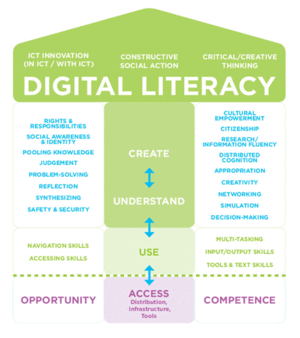Digital Literacy
From DigitalRhetoricCollaborative

Digital literacy is the ability to effectively use digital technology, communication tools or networks across multiple formats and a wide range of sources in order to locate, evaluate, use or create information digitally. This form of literacy further entails that a person has the ability to read and interpret media, to replicate data and images through digital skills, and to evaluate and apply new knowledge and information gained from digital sources[1].
Contents |
History
The concept of digital literacy has evolved in the 21st century from the basic definition of literacy, “traditionally understood as the ability to read and write[2].” In order to be successful in the digital world today, literacy goes beyond the ability to read and write. The term “digital literacy” has been used since the 1980’s but in a narrower sense of being able to effectively use computers, such as in one’s work[3]. Paul Gilster, author of digital literacy texts, expanded the concept in 1997 by describing it as “… the set of attitudes, understanding and skills to handle and communicate information and knowledge effectively, in a variety of media and formats[4].” Gilster’s idea was broader and not constrained to a specific set of skills, attitudes, or competencies in the definition of what it is to be digitally literate. However, a modern sense of the definition is seen as a combination of cultural, cognitive and technical resources, exemplified through Futurelab’s (the British educational research organization) definition: “To be digitally literate is to have access to a broad range of practices and cultural resources that you are able to apply to digital tools. It is the ability to make and share meaning in different modes and formats; to create, collaborate and communicate effectively and to understand how and when digital technologies can best be used to support these processes[5].” The evolution of what it means to be digitally literate reflects the change in how information is processed, delivered, and received in the digital age.
Digital literacy refers to the variety of literacies that are associated with use of digital or “new” technologies, including:
- mobile devices (mobile phones, smart phones, laptops, tablets, etc.)
- desktop computers
- data logging equipment
- interactive whiteboards
- digital recording devices (cameras, video recorders, voice recorders)
- general resources on the internet
Key Components
Use in Education
Today students are wired to learn digitally and are immersed in the digital world with technology always within reach. The concept of eLearning has become popular due to the affordance of convenience, allowing learning to take place at a time and location that’s better suited to the learner’s needs[6]. In order to effectively utilize the tools associated with eLearning, there must be a corresponding level of digital literacy.
Use in Society/Workplace
Digital literacy is an important topic and skill because technology is developing more rapidly than society is. Because of the unprecedented capabilities and environments that technology provides, appropriate behavior and use in these digital contexts is a work in progress and may be unknowable in certain situations due to a lack of experience. Previously concrete and well-established ideas such as copyright, academic integrity, and privacy are now difficult define or in constant flux[7]. The use of eLearning in the workplace is particularly advantageous for large organizations that have a multitude of employees working in different locations working on projects and processes that require communication and collaboration with one another[8].
References
- ↑ "Digital Literacy Definition and Resources." University Library of Illinois at Urbana-Champaign. University of Illinois at Urbana-Champaign, 15 Oct. 2008. Web. http://www.library.illinois.edu/diglit/definition.html
- ↑ http://en.wikipedia.org/wiki/Literacy
- ↑ Mohammadyari, Soheila, and Harminder Singh. "Understanding The Effect Of E-Learning On Individual Performance: The Role Of Digital Literacy." Computers & Education 82.(2015): 11-25. Academic Search Complete. Web.
- ↑ Gilster, Paul. Digital Literacy. New York, 1997. Print.
- ↑ http://www2.futurelab.org.uk/resources/documents/handbooks/digital_literacy.pdf
- ↑ Mohammadyari, Soheila, and Harminder Singh. "Understanding The Effect Of E-Learning On Individual Performance: The Role Of Digital Literacy." Computers & Education 82.(2015): 11-25. Academic Search Complete. Web.
- ↑ "Digital Literacy Resource - Introduction." Cornell University Digital Literacy Resource. Cornell Information Technologies, 1 Jan. 2009. Web. https://digitalliteracy.cornell.edu/welcome/dpl0000.html
- ↑ Mohammadyari, Soheila, and Harminder Singh. "Understanding The Effect Of E-Learning On Individual Performance: The Role Of Digital Literacy." Computers & Education 82.(2015): 11-25. Academic Search Complete. Web.
External Links
--Samantha Lipkin April 22, 2015
